Palm Trees: The Complete Guide (With Pictures)

Palm trees evoke thoughts of tropical sandy beaches, warm sunshine, or beautiful colorful sunsets with silhouettes of tall, slender palms with crowns or arching feather-like fronds. However, many types of cold-hardy palm trees grow in cold climates and can even withstand freezing temperatures. Also, many dwarf palm trees have shrubby growth and only grow a few feet above the ground. Additionally, a wide variety of palm trees produce fruit in the form of coconuts, dates, drupes, and berries.
There are over 2,600 species of palm trees, most of which grow in tropical and subtropical climates. Palm trees are identified by their branchless stems, fan-shaped or feather-like fronds (leaves), and size. Depending on the species, palm trees have smooth, ringed, or shaggy trunks covered in husks.
Various species of palms have distinct characteristics, making them easy to identify. Palm trees grow in coastal locations, rainforests, and deserts.
This article is a general guide to palm trees and the different types of palms you will come across.
What are Palm Trees?
Palm trees are a type of perennial, evergreen flowering plant in the family Arecaceae. Palm plants can have tree-like growth or grow as stemless shrubs. Palm trees and shrubs have leaves called fronds that are either shaped like a fan or are feather-like with arching petioles and pairs of pointed linear leaflets.
Palm trees can be described as “self-cleaning.” This means that the large fronds fall cleanly away from the stem, leaving a smooth “trunk.” However, other palm fronds break off the stem and leave diamond-shaped husks, creating a rough, shaggy stem.
Palm trees with fronds in the shape of a fan are called palmate leaves, meaning they have several leaflets emerging from a single point. Feather-like palm fronds are called pinnate, with pairs of leaves growing along the central stalk or stem.
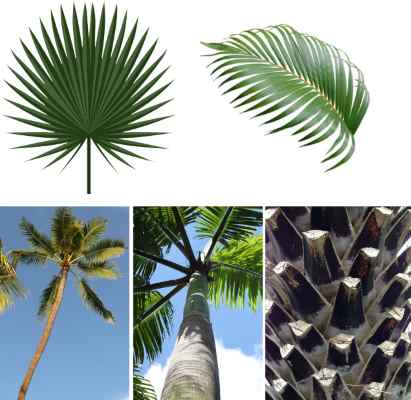
Identification features of palm trees include the leaf shape, height and the trunk appearance
What are the Different Types of Palm Trees?
Palm trees can be tall, single-stemmed plants with smooth or rough stems and crowns of arching fronds. Other types of palms look more like shrubs, with multiple leaf stems that grow directly from the ground. Types of palm trees can also be categorized by the type of fruit they produce.
Here are descriptions of some of the most popular and common palm tree varieties:
Coconut palm tree
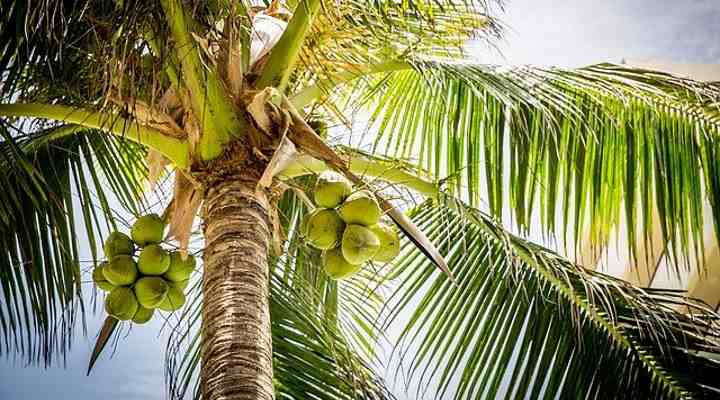
Coconut palm tree (Cocos nucifera)
The coconut palm tree (Cocos nucifera) is a tall, single-stemmed palm with smooth, ringed trunks and a crown of arching fronds. It is one of the most recognizable palm trees and the only coconut-producing palm. The coconut palm thrives in tropical climates in sandy soil and can reach heights of up to 100 feet (30 m). It has a long lifespan and can live for up to 80 years.
Date palm tree
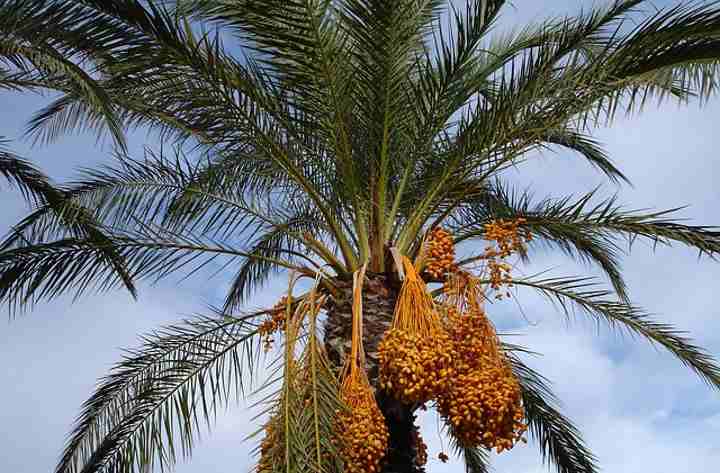
Date palm tree (Phoenix dactylifera)
Date palm trees are easily recognizable due to their tall, solitary rugged stems and spreading crowns of curving fronds and bunches of juicy fruits. Several palm varieties produce dates, but only cultivars from the Phoenix dactylifera genus are prized for their edible dates. Other date-producing palms are not particularly tasty.
Date palms, like the popular Canary Island date palm (Phoenix canariensis), have huge bunches of fleshy drupes that can be brown, orange, or red colors. Typically, these slow-growing tall, slender palm trees grow 60 to 100 ft. (18 – 30 m) tall and live for over 100 years.
Tall palm trees
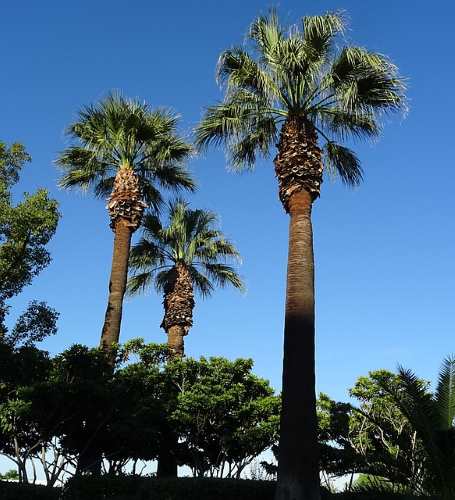
The ornamental California fan palm (Washingtonia filifera) can grow up to 66 ft. (20 m) tall
Tall palm trees are a type of single-stemmed palm tree with smooth or rough trunks and a crown of arching fronds. These tall, elegant palms typically grow in tropical regions and are common in California, Florida, and other southern states. These palms typically grow between 60 to 100 feet tall.
The most common tall palm trees are the royal palm (Roystonea regia), Canary Island date palm (Phoenix canariensis), and California fan palm (Washingtonia filifera).
Small palm trees
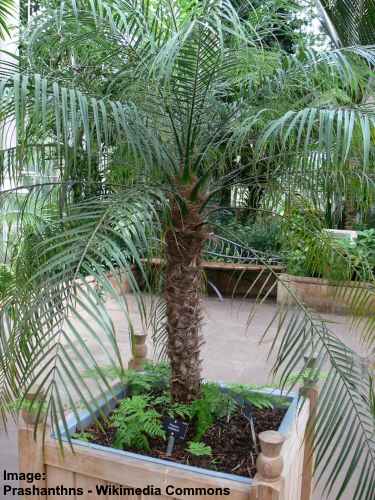
The pygmy date palm (Phoenix roebelenii) is a small tree that grows up to 10 ft. (3 m) tall
Small palm trees typically grow less than 20 ft. (6 m) tall. These low-growing palm trees are common in garden landscaping because of their compact size. Usually, small palms have rough, smooth, or ringed stems with arching crowns of large fronds. Here are some examples of small palm trees suitable for landscaping:
- Pygmy date palm (Phoenix roebelenii)
- Pindo palm (Butia odorata)
- European fan palm (Chamaerops humilis)
- Spindle palm (Hyophorbe verschaffeltii)
Bushy palms

Needle palm (Rhapidophyllum hystrix) has a bushy growth habit and can grow as a miniature patio palm
Bushy palms are typically shrub-like plants with stems that emerge from the ground. Depending on the species, low-growing clump-forming palms with bushy growth have pinnate leaves, like the parlor palm (Chamaedorea elegans) or dwarf sugar palm (Arenga engleri). Some bushy palms have palmate leaves, including species like the dwarf palmetto (Sabal minor) or needle palm (Rhapidophyllum hystrix).
Cold hardy palm trees

Bismarck palm (Bismarckia nobilis) tree has beautiful silvery gray foliage and it tolerates short frosty conditions
Cold-hardy palms typically grow in warmer climates but can withstand short periods when temperatures dip below freezing. Some palms can grow well in temperate climates and tolerate snow and hard freezes. Types of cold-hardy palms include the eye-catching Bismarck palm (Bismarckia nobilis), the windmill palm (Trachycarpus fortunei), and the Cabbage palm tree (Sabal palmetto).
What are the Characteristics of Palm Trees? / How Do Palm Trees Look Like?
Identification features of palm trees are their green fronds—palmate (fan-shaped) or pinnate (feather-like) and stems. In addition, many types of palm trees have smooth stems with a green crown shaft. In contrast, others have rugged, rough-looking stems covered in husks from dead palm leaves. Other identifying features are plant size, shape, and the number of stems.
Palm tree stem
The stem of a palm tree is typically a slender cylindrical tube that sometimes bulges at the base. Most palm tree trunks (stems) are branchless. However, it is common for stems to have rings around the grayish stems. Other shaggy palm stems have a husk-like papery growth that is remnants of dead stems.
Palm tree crown shaft
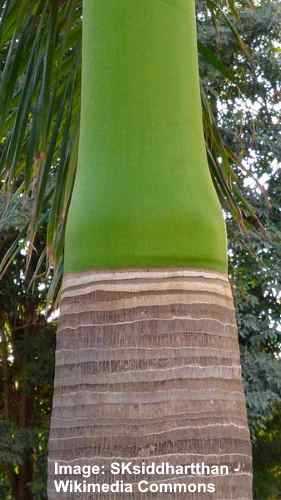
Crown shaft base of Royal palm
A palm tree crown shaft is a smooth, green part of the stem visible on some palms just below the crown. The crown shaft is typically on tall, slender palm trees. The most well-known palm tree with a noticeable crown shaft is the royal palm (Roystonea regia).
Palm tree leaves
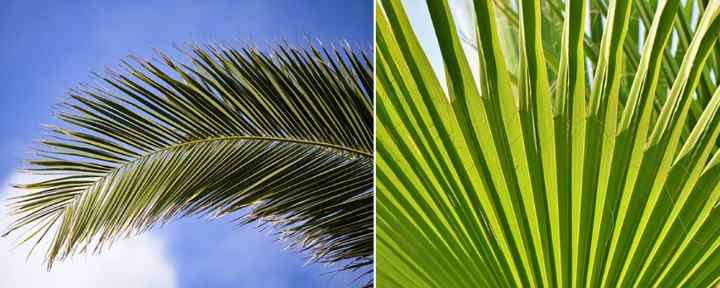
Palm tree leaves (fronds) can be pinnate (left) or palmate (right)
Palm tree leaves are called fronds. These leafy growths are usually in the shape of a fan and are called palmate leaves. This type of palm leaf has several leaflets emerging from a single point, creating a circular leaf shape. Feather-like palm fronds are called pinnate, and these have pairs of leaflets growing along the central stalk or stem.
Palm tree flowers
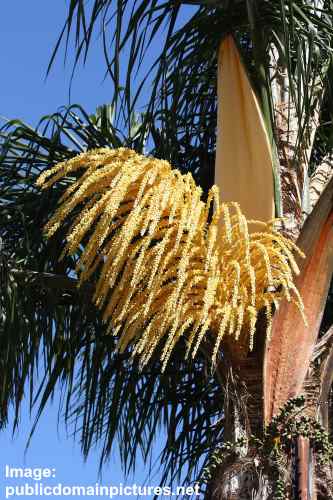
Palm tree flowers
Palm trees produce flowers that are typically small and yellow or white in color. The flowers are usually clustered together in a spiky inflorescence – the flowering part of the palm tree. These flowers are pollinated by insects and birds, and once pollinated, they will develop into fruits. Depending on the species, palm tree fruits can be edible or inedible.
Palm tree fruit

Açaí palm fruit
Palm tree fruits are edible or inedible fruits that include dates, coconuts, and acai berries. Depending on the species, these fruits vary in size, shape, and color. Some of the most common edible fruits are dates from the date palm. However, the flesh and juice from coconuts are reminiscent of tropical, exotic islands.
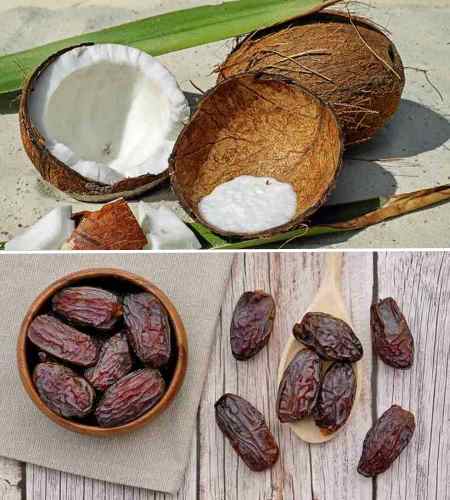
Mature fruit of coconut palm tree (top) and Medjool dates (bottom)
Palm tree seeds
Palm tree seeds are either the small round to oval stone of dates, acai berries or the white fleshy area of coconuts.
How Fast do Palm Trees Grow?
Palm trees have varying growth rates depending on their species and the environment. However, compared to many species of hardwood trees, palms typically have slower growth, not growing more than 2 ft. (0.6 m) per year.
Slow-growing palms typically grow less than 1 ft. (0.3 m) per year. Examples of palm trees with slow growth are the European fan palm (Chamaerops humilis), lady palm (Rhapis excelsa), windmill palm (Trachycarpus fortunei), and foxtail palm (Wodyetia bifurcata).
Palms with rapid growth typically add between 1 and 2 ft. (0.3 – 0.6 m) annually to their height until they reach maturity. Examples of palms with the fastest growth are palm trees that dominate the Florida, Texas, or California skyline. These include the following species:
- Mexican fan palm (Washingtonia robusta)
- King Palm (Archontophoenix alexandrae)
- Queen Palm (Syagrus romanzoffiana)
What Type of Fruit Grows on Palm Trees?
Here are some descriptions of the most common palm tree fruits:
Coconuts: Not technically a nut, but it is a drupe. Young coconuts have glossy outer skin that is usually yellowish-green. As the fruit matures, a hard seed develops covered in a fiber called coir with a white fleshy interior. These are filled with coconut water or juice.
Dates: Clusters of small oval-shaped fruits with juicy flesh grow on many palm trees. These can be orange, red, or dark brown and measure usually up to 1” (2.5 cm), with smaller varieties or larger such as Medjool dates.
Acai berries: These small grape-like fruits are dark purple or blackish-colored fruits with a sweet flavor.
What Palm Trees Grow Coconuts?
Coconuts only grow on palm trees in the genus Cocos nucifera. Coconut palms are solitary trees that grow 100 ft. (30 m) tall and are common near beaches and coastal areas. Coconut palms have arching pinnate leaves measuring 13 to 20 ft. (4 – 6 m) long. The “nuts” grow in clusters near the crown and have a thick, smooth outer skin covering a hard, fibrous seed.
Are Palm Trees Cold Hardy?
Certain types of palm trees are cold-hardy and can survive cold temperatures for brief periods. The cold-hardiest palms can even tolerate some snow and hard freezes. Cold-hardy palm trees are typically native to warmer areas of North America’s temperate zone and Asia’s mountainous regions.
Even some tall palm trees associated with tropical regions can tolerate short spells of freezing temperatures.
What Palm Trees are Cold Hardy?
It can be tricky to choose cold-hardy palm trees for a garden landscape. The first step is to choose one suitable to your USDA growing zone. Then it’s best to choose a relatively mature tree to withstand cold conditions better. Then, ensure its growing location is in a spot protected from the wind.
Here are some of the best cold-hardy palms for your garden:
Bismarck palm (Bismarckia nobilis): A spectacular palm with blue-green fan-shaped fronds. It can withstand temperatures as low as 25°F (-4°C).
European fan palm tree (Chamaerops humilis): Multi-stemmed palm with rough stems and palmate fronds. It’s cold-hardy to 10°F (-12°C).
Chinese fan palm tree (Livistona chinensis): Hardy to 15°F (-12°C), it’s an upright, elegant cold-hardy palm tree with drooping pinnate leaves.
Windmill palm tree (Trachycarpus fortunei): This cold-hardy palm tree for USDA zones 7 to 11 has palmate leaves on long petioles. Can survive cold snaps as low as 5°F (-15°C).
What Palm Trees Grow Indoors?
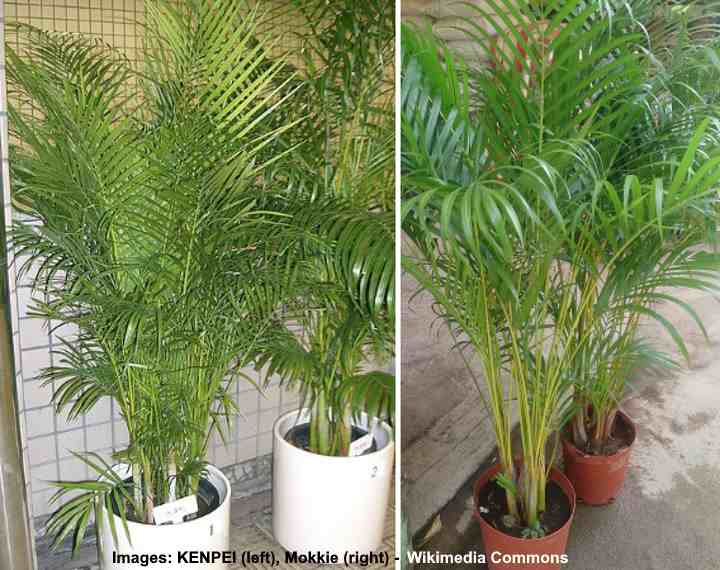
Areca palm (Dypsis lutescens) can be grown indoors and will give a tropical look to any space
Growing palm trees indoors can be a great way to bring a bit of the tropics into your home. Palms are relatively easy to care for and can add a unique touch to any room. Types of palm plants for indoors typically thrive in room temperatures and away from direct sunlight.
Here are some palms suitable for planting in containers indoors:
Areca Palm (Dypsis lutescens): A popular indoor clumping palm that has long, feathery-like fronds that arch gracefully from the center of the plant.
Parlor Palm (Chamaedorea elegans): This small, slow-growing palm is perfect for small spaces. Its attractive pinnate fronds grow up to 6 ft. (1.8 m) tall.
Kentia Palm (Howea Forsteriana): This slow-growing elegant palm plant has graceful arching fronds that make it an attractive addition to any room. It prefers shade and doesn’t grow too large indoors.
What are Dwarf Palm Trees?
Dwarf palm trees are perfect for landscaping residential gardens in subtropical or tropical climates. Typically, small and dwarf palms don’t grow taller than 20 ft. (6 m) tall. However, with their palmate or pinnate fronds, these exotic plants can create a beautiful, lush look in any garden.
Here is a list of a few dwarf palm trees suitable for small, compact gardens in southern climates:
- Dwarf palmetto (Sabal minor)
- Pygmy date palm (Phoenix roebelenii)
- Windmill palm tree (Trachycarpus fortunei)
- Spindle palm (Hyophorbe verschaffeltii)
- Triangle palm tree (Dypsis decaryi)
How Long Do Palm Trees Live?
Palm trees live between 40 and 120 years, depending on the species and growing conditions. Palm trees that live between 70 and 100 years are the date palm, Mexican fan palm, coconut palm, and date palm. However, some palm trees have a shorter lifespan, like the areca palm, which only lives around 50 years.
How to Grow Palm Trees
Like with any tree, growing palm trees in your yard requires selecting the right type of tree for your growing zone, climate, and sun exposure. Typically, it’s best to choose small or dwarf palm trees for a backyard. Or, you can grow them in containers outdoors to restrict their height.
Other considerations when choosing which palm trees to grow in your garden landscape are their growth rate, mature height, and maintenance needs. Low-maintenance palms suitable for growing in a yard are the king palm tree (Archontophoenix alexandrae), pygmy date palm (Phoenix roebelenii), and the foxtail palm (Wodyetia bifurcata).
How to Grow Palm Trees From Seeds
Growing palm trees from seeds is a rewarding and exciting experience. You can order palm seeds online or collect fresh seeds from mature flowering palm trees. To test if the seeds are viable, drop them in a glass of water. The ones that sink have the most chance of germinating.
To grow a palm tree from seed, place a few seeds in a small container with well-draining compost. Then, cover them with a light layer of soil. After that, cover the container with plastic and put it in a warm, humid room. Once the palm plant has sprouted, repot them in individual 4” (10 cm) containers.
After a few leaves have grown, transfer to a larger container and keep the small palm plant in a warm, bright, humid environment out of direct sunlight.
How to Plant Palm Trees
The best way to landscape a front or backyard with a palm tree is to buy a mature tree. These typically come in 3-gallon containers.
To plant the palm, choose a suitable location with plenty of sunlight. Then, dig a hole twice as large as the root-ball and a few inches deeper. Put a 6” (15 cm) layer of sand in the base. Next, put some slow-release palm fertilizer in the hole and work it into the sides and bottom.
After that, place the palm in the root-ball in the hole and backfill with one part native soil and one part compost. Press the soil down to ensure no air pockets and water thoroughly. Lastly, put a 6” (15 cm) layer of organic mulch over the root area. Water daily for the first week.
Tips for Caring for Indoor Palm Trees
To care for a palm plant indoors, grow it in fertile soil with good drainage. Only water the soil when the top layer is dry. Maintaining high humidity and temperatures between 65°F and 85°F (18 – 29°C) is also vital. To ensure optimal growth, keep indoor palms in a bright spot but out of direct sunlight. You should fertilize your indoor palm tree every month.
How to Care For Palm Trees Outdoors
Palms trees growing in your garden typically require little—if any—maintenance. A newly planted palm tree requires watering daily. However, established palm trees are drought-tolerant and don’t need extra watering. Apply a slow-release palm fertilizer in early spring.
Winter Protection For Palm Trees Growing Outdoors
Palm trees growing outdoors in cold climates may need extra protection during winter. To protect your palm tree from frost damage, wrap the stem with a frost cloth or burlap and, if possible, cover the fronds with a tarp. This will help to insulate the plant and keep it warm. Additionally, it’s a good idea to water the tree thoroughly before severe frosts and add a thick layer of mulch.
Related articles:
